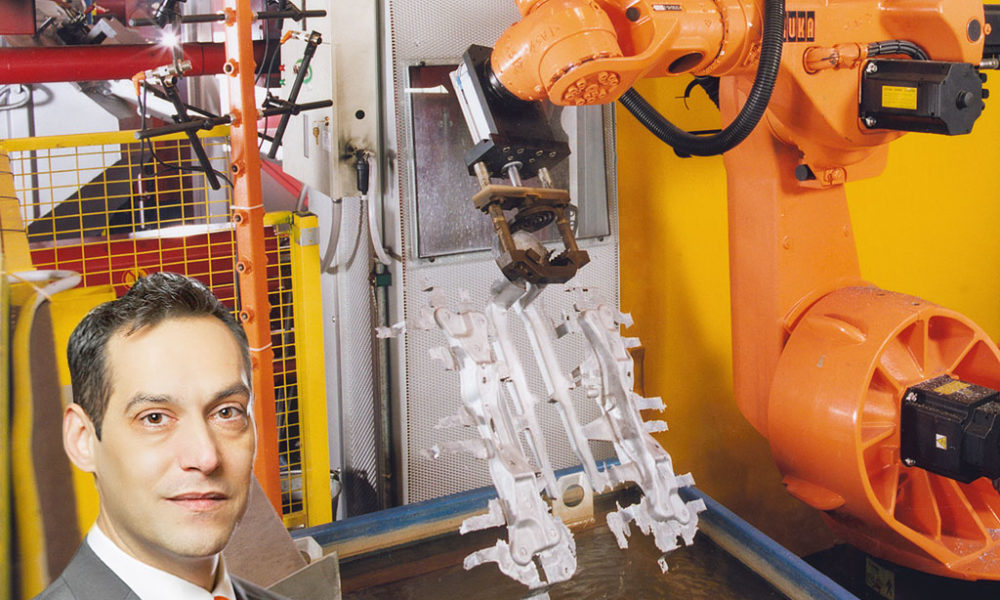Robotics and the Future of Foundry
By OEM Update Editorial August 14, 2017 3:06 pm IST
Foundry robots optimise the production process wherever it is of decisive importance to achieve a degree of reproducibility that cannot be matched by human operators.
– Thomas Angerbauer, Market Segment Manager – Foundry Division, KUKA Roboter GmbH
Thomas Angerbauer, the Market Segment Manager for the Foundry division at KUKA Roboter GmbH, explains why automation in foundries provides clear advantages and how the potential in this market will develop.
Mr. Angerbauer, what role do robots play in the foundry industry?
Every year in Germany’s foundries, five million tonnes of metal are employed in manufacturing high-quality parts and components. This amount puts the German foundry industry in a leading position in Europe and in fourth place worldwide – behind China, the US and Japan. Foundry products are highly diversified, especially in the automotive industry. Consequently, flexibility in production is an important feature of the sector, particularly since automobile manufacturers renew their models in a cycle of between two and three years. As a result of its harsh production conditions and the simultaneously high quality requirements from customers, the sector is also an ideal candidate for the use of modern robot systems.
The environment in foundries places an enormous strain on people and machinery. It is extremely hot there, molten metal must be transported, there is a lot of dust and, often, it is very humid in the work areas. Both humans and machines have to be very robust in such an environment. In addition, there are exacting requirements on product quality, reproducibility, flexibility in production, quantities and time sequences. Foundry robots optimise the production process wherever it is of decisive importance to achieve a degree of reproducibility that cannot be matched by human operators. For example, in the spraying processes during die-casting, when inserting cores or removing flash during finishing, where hot and molten metals are poured and checked, patterns are immersed or heavy castings have to be moved. And, of course, also wherever there is a hazardous potential for accidents, e.g. when pressing or stacking, and where extreme heat, copious dust, gases or moisture push human endurance to the limits.
You introduced two new robot types from the KR QUANTEC series – the KR 270 R3100 ultra K shelf-mounted robot and the KR 120 R2100 nano F exclusive. Why further development was necessary and what can these robot types be used for?
Robots need to meet a number of requirements for the new, innovative casting processes. At the same time, a surface that is resistant to heat, corrosion, alkalis and acids is just as essential as special seals on the motor and gear unit flanges. The new KUKA KR 270 R3100 ultra K shelf-mounted robot has a reduced volume and, as a result, has the best payload/reach combination in the entire KR QUANTEC series. It is thus perfectly suited for unloading larger workpieces from machines. The new member of the KUKA KR QUANTEC Foundry family, the KR 120 R2100 nano F exclusive, is an addition to the compact range of the series. The robot meets the conditions of protection rating IP69, while its in-line wrist even complies with those of IP67 and IP69. With its compact reach of 2,100 mm and a payload capacity of 120 kgs, the six-axis robot is particularly suitable for work in confined spaces, e.g. in washing and cleaning cells. It has a pose repeatability of 0.06 mm.
As a prime robot manufacturer, what potential do you foresee in the foundry market over the next few years?
Foundries need to further reduce their production costs. That can be achieved through new technologies and the introduction of innovative processes. Only in this way can they remain economically viable in the face of competing manufacturing processes. Modern robots are already making a decisive contribution in this context today. The automation potential through the use of robots has by no means been exhausted. We expect that the deployment of robots will continue to grow significantly in foundry production in the medium to long term. For die-casting, KUKA is currently developing a new cell concept called “Pioneering die-casting automation”. Not only does this include new hardware and software solutions, it also provides expansion interfaces through to cell visualisation and process data acquisition. With concepts such as this, we enable the high and verifiable levels of reproducibility that foundries need nowadays.
Cookie Consent
We use cookies to personalize your experience. By continuing to visit this website you agree to our Terms & Conditions, Privacy Policy and Cookie Policy.
















